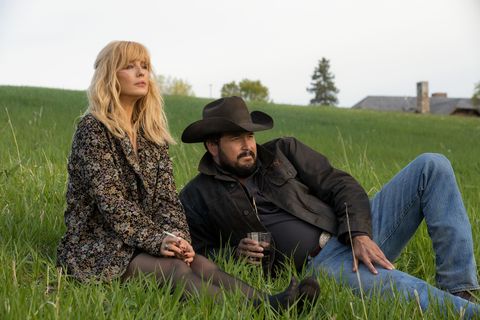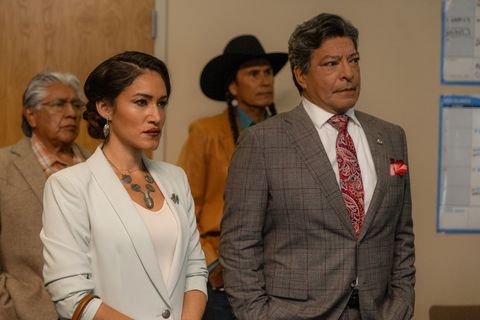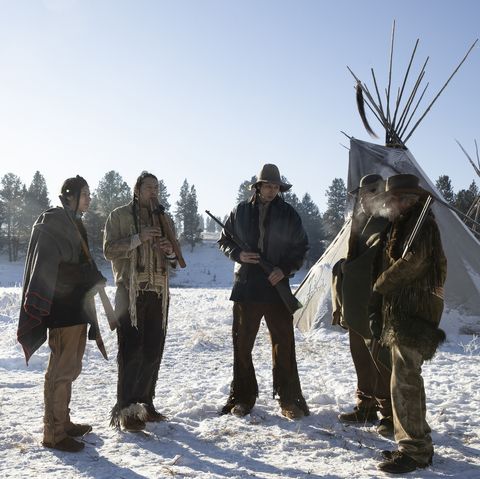Whether you love or loathe John Dutton and what his fatally flawed Montana family represents, there’s no denying the power of Yellowstone. The one-time sleeper Paramount series is now the hottest show on TV, with nearly 16 million viewers tuning in for the season 5 premiere earlier this fall. And while the neo-Western’s fan club is bigger than ever, few know the Black female costume designer behind the show’s signature looks: Johnetta Boone. With 30 years in the industry under her belt, Boone trained at the Fashion Institute of Technology then went on to work on Hollywood hits like The Notebook, Cadillac Records, and Hustle.
Starting with season 2, the Washington D.C. native took over the Yellowstone reins from Oscar winner Ruth E. Carter, a Black trailblazing costume designer herself. Since then, Boone has been encapsulating the Western lifestyle with American heritage brands like Levi’s, Wrangler, and Carhartt. But just like the show’s complicated plot, the costumes aren’t quite that simple—she also features vintage finds; high-fashion heavyweights like Gucci, Louis Vuitton, and Off-White; and up-and-coming Indigenous designers like Bethany Yellowtail. For both Boone and show creator Taylor Sheridan, getting every detail right is crucial, which is why she does plenty of research and partners with on-set Director of Indigenous Affairs Mo Brings Plenty (who plays Mo on the show) to ensure the Native American attire is culturally appropriate.
Here, Boone talks with ELLE.com about dressing the Duttons and the ranch’s motley crew of cowboys.
What research did it take for you to capture the cowboy ethos?
Western culture spans all regions, and there’s actually a huge cowboy culture here [in Washington, D.C.], like the Bill Pickett Rodeo. In my teens, I rode every weekend for about four years, and my husband and I have friends with horses. So the territory wasn’t as unfamiliar as one would think. I’m by no means an equestrian, but riding all those years ago helped me understand the elements of Western culture. When I inherited the show for season 2, I submerged myself in the local culture, visiting grocery stores and casinos to incorporate that lifestyle into the world of Yellowstone. Taylor Sheridan, the mastermind behind the show, wants everything to be authentic, so I don’t take a lot of liberties stylistically.
So many characters have signature looks, from John Dutton to Beth to Rip to Thomas Rainwater. How do you so adeptly convey these strong personalities through clothing?
It’s really important to make sure everyone is distinct, which in turn creates distinction between their worlds. JD—John Dutton—is the owner of the ranch and one of the most powerful business owners in the region, but he’s still a cowboy. We translate that with high-end brands, like Double RL jeans as opposed to your average Wrangler jeans, and with custom pieces that allow for a bit more diversification when it comes to fit, fabric, and color.
Beth is well-traveled, yet it’s important we still show she’s from Montana. We show her softer side with prairie dresses and florals when she’s with Rip, but she also has a strong business style with European flair. Her looks are so strong with power in season five. She wears a lot of Alexander McQueen blazers, which give really great angles. People are often surprised at all the brands I use on the show—everything from Wrangler to Gucci to Vuitton.
With Rip, because of his past, his colors remain dark. It looks like he wears the same thing all the time, but his shirts are different. Some are cotton, some are Western, some are more outdoorsy. And I over-dye a lot of his shirts so the black is more of a softer green black, which he wears when he’s with Beth, or a harder blue black, which he wears in scenes with the cowboys. The average viewer might not notice these subtle details, but it adds mood and depth to the tone.
Rainwater, who is a businessman and politician, is almost always in business attire so there’s no question about his level of power or where he stands. He has to walk a tightrope trying to navigate the world of politics. If we went with a more Indigenous look, that would send a different message. Because the Crow community—the tribe represented in the show—is very colorful, we add in some color that separates him from your average well-versed businessman, like turquoise lapel pins and rings. Not everyone can pull off color, but he does so handsomely.
When it comes to brands, how do you honor tradition without getting stuck in the past?
Everyone’s doing a take on Western wear right now, so it’s a little easier not to get stuck in a time warp. I always make sure the elements we’re using transcend time, whether that’s the print or the weave of the fabric. Brands like Levi’s, Carhartt, and even Wrangler are constantly reinventing themselves, which allows me to bring forward some of those traditions. Ralph Lauren still represents a bit of the original heritage. With Double RL, he pulls on early 19th and 20th century pieces and brings them into a modern Western flavor. I also dabble in newer brands like Buck Mason and Patagonia workwear, and I can even sneak in more forward brands like COS and Ulla Johnson without them looking out of place.
You take particular care in crafting culturally appropriate costumes for Native American characters. How do you approach that?
For so long, the Indigenous community has been overlooked and not well-respected, so it’s so important for us to represent Native American culture truthfully, respectfully, and with integrity. I look to Mo Brings Plenty, our on-set Director of Indigenous Affairs, for help with every tiny detail down to the specific colors and what they represent. I’ve learned so much from him.
We work with a lot of Indigenous artisans to get it right. For instance, when we did the flashback to 1893 in season four, Mo connected me with a maker who still works in the fabrications and beadings of the past. She explained to me that the Native Americans in that era would wear pouches around their necks made with brain-tanned leather, which involves a ceremonious process. So we had those handmade using brain-tanned leather.
Then in season five for Monica and Kayce’s baby’s memorial service, given the sensitivity that scene encompasses, we used brain-tanned leather for Monica’s moccasins. We worked with an Indigenous beader to hand make her moccasins and ensured every detail was right, from the leather to the color of the beads. Most of this information isn’t written down or available online; you have to go to the people within the culture to learn this knowledge that’s been passed down over time.
What’s it like for you to be one of few Black creatives working on this show?
I’ve always been one of a handful of Black creatives on every project I’ve ever done. In the beginning of my career, I definitely recognized I was the only person of color in a room of 40 people during a production meeting. There’s been an invitation for more people of color to come into the film and television industry recently. But even today, I’m still usually the only or one of two Black department heads during production meetings. No one looks at me as being a Black female costume designer, because I’ve never looked at myself that way. I’m just a costume designer. My skills and experience are why I have a spot at the table.
What’s your response to those who say Yellowstone is tailored for a conservative white audience?
I would say they’re right, because that’s the world the show lives in. In Montana, there’s zero diversity. How many people of color are working on the Dutton Ranch? One. How many people of color work on the majority of ranches across the country? So of course the show speaks to a conservative audience, because that’s the culture of the place. But that doesn’t mean Taylor [Sheridan] or those of us working on the show are conservative.
It’s just now that the liberal community is really digging Yellowstone. They weren’t tuning in because they thought it was a cowboy Western, but now they’re binge-watching every season. They’re realizing the story being told is one that transcends race, heritage, culture, and community. You’re fighting for your land; you’re fighting for your family.
How do you think Yellowstone has impacted the fashion world?
Yellowstone has impacted the fashion world greatly. Western looks are showing up everywhere, from street style to the catwalk. You’ve got Western yokes showing up in boutiques, like the Frankie Shop in New York. On the streets of Manhattan, people who have never bought cowboy boots before are walking down the street wearing them creatively—with baggy jeans, cargo pants, and sweatpants. And people are investing in custom-made cowboy hats. It’s showing up everywhere.
What have you learned about the American West through working on the show?
The American West is pure and authentic. Before working on Yellowstone, I’d never visited Montana, and that’s a world unto itself. There are no hotels where we shoot, so each of us has a house up in the mountains—but that house might not have Wi-Fi. Originally we thought, “How can these people live without Wi-Fi?” Guess what? They are alive and thriving.
In the morning, you open the window, breathe in the fresh air, and take in the beautiful sunrise. At night, you can see all the stars in the sky. Time has stopped there. If you’re in a hurry, don’t go to places like Montana, because everyone is taking their time to do the things that matter in life. Some of the cowboys out there make pennies on the dollar, but they do it because they love it. It’s a very grounding experience, and you settle into a simpler way of life. Then when you come back to a big city, your perspective is different. Working on Yellowstone reminds me just how precious life is.
This interview has been edited and condensed.
An Alaska Native Tlingit tribal member, Kate Nelson is an award-winning writer and editor living in Minneapolis.







